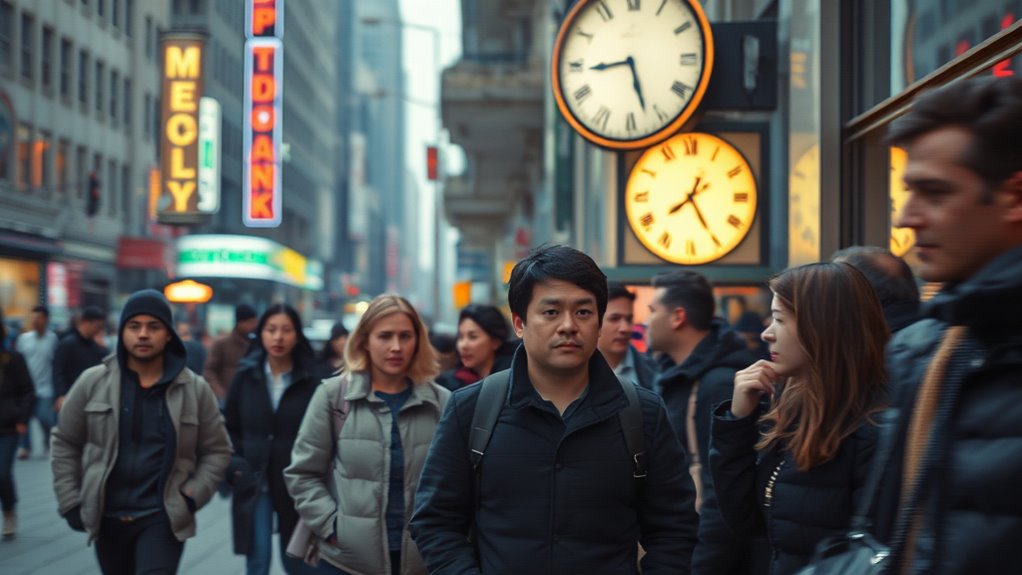Glitches in reality, like the Mandela Effect and personal synchronicities, suggest your perception might not be as fixed as you think. These phenomena can feel like glimpses behind the curtain of a layered universe, where memories and coincidences hint at alternate timelines influencing your experience. As you explore these anomalies, you’ll discover how they challenge your understanding of reality, revealing an intricate, interconnected fabric that’s more mysterious than it seems. Keep exploring to uncover what lies beneath.
Key Takeaways
- Glitches in reality refer to anomalies like the Mandela Effect, where collective memories conflict with documented history.
- Personal synchronicities are meaningful coincidences indicating shifts into alternate timelines or realities.
- These phenomena suggest reality is layered and interconnected, with consciousness potentially shifting between different versions of events.
- Such anomalies challenge fixed perceptions, implying reality may be more fluid and influenced by parallel universes.
- Recognizing these glitches invites reflection on the nature of perception, reality, and the possibility of multiple, overlapping layers of existence.

Have you ever wondered if the world around you is perfectly consistent, or if occasional anomalies hint at deeper cracks in reality? Many people believe that what we perceive as reality might not be as stable as it seems. Instead, it could be a complex tapestry woven from multiple layers, where parallel universes subtly influence our experiences. These alternate realities, or parallel universes, suggest that our consciousness might sometimes shift between different versions of the same moment, creating what we experience as glitches or anomalies. When these shifts happen, you might notice strange similarities or small contradictions—like recalling a different spelling of a familiar brand or remembering a famous quote differently. These are often considered manifestations of consciousness shifts, where your mind temporarily aligns with an alternate version of reality. Some researchers propose that these phenomena could be linked to multiverse theory, which posits the existence of multiple, co-existing universes beyond our observable realm.
The Mandela Effect is a prime example of this phenomenon. It refers to collective memories that clash with documented history, causing many to question their memories or the fabric of reality itself. You might vividly remember how a popular children’s book or a logo looked, only to find out that your memory doesn’t match the current reality. Some interpret these discrepancies as evidence that your consciousness has momentarily shifted into a parallel universe where different events occurred. These shifts can feel surreal, like glimpsing behind the curtain of what’s “really” real, making you wonder if your mind is playing tricks or if there’s a deeper, more mysterious process at work.
The Mandela Effect reveals how collective memories can clash with reality, hinting at shifting consciousness and parallel universes.
Personal synchronicities often serve as subtle hints that reality isn’t entirely fixed. When you experience a coincidence that feels too meaningful to be random—like thinking of someone just before they call you or repeatedly noticing a specific number—it can be a sign that your consciousness is tuning into a different frequency. These moments may suggest that your mind is temporarily aligning with a different timeline or parallel universe, where different choices or events are playing out. Some believe that these synchronicities are intentional signals from the universe, guiding you toward certain paths or helping you understand that your perception of reality is more fluid than you might think.
Ultimately, these glitches serve as reminders that reality might be more layered and interconnected than it appears. Whether you see them as proof of parallel universes, consciousness shifts, or simply interesting coincidences, they challenge your understanding of what’s real. They invite you to question whether your perceptions are fixed or if, at any moment, your consciousness could be shifting into a different version of reality—one where the rules are a little more flexible, and the fabric of existence is a lot more mysterious.
Frequently Asked Questions
Can Glitches in Reality Be Scientifically Proven?
You wonder if glitches in reality can be scientifically proven. While some suggest quantum anomalies and perception distortions might explain these phenomena, concrete scientific proof remains elusive. Researchers struggle to replicate or verify such occurrences consistently, making it difficult to establish them as factual. So, at this point, these glitches stay in the domain of hypotheses and anecdotal evidence, rather than confirmed scientific facts.
How Do Personal Synchronicities Differ From Shared Glitches?
You might think personal synchronicities are just random coincidences, but they’re actually rooted in your subjective perception and memory reliability. Unlike shared glitches—public anomalies everyone notices—personal synchronicities feel uniquely significant to you. Ironically, your mind weaves these moments into a narrative, making them seem extraordinary, even though they stem from how you interpret and remember events. It’s a fascinating dance between perception and reality that only you experience.
Are There Historical Examples of Widespread Mandela Effects?
You might wonder if there are historical examples of widespread Mandela Effects. Historically, anomalies like the Berenstain Bears spelling or the Lincoln Memorial statue’s appearance have altered collective memory. These changes often cause confusion and debate, showing how shared perceptions can shift over time. Though not all are proven, these collective memory glitches highlight how perception and reality sometimes diverge, creating fascinating examples of historical anomalies affecting many people’s memories.
What Role Does Collective Consciousness Play in These Phenomena?
You might wonder how collective awareness influences these phenomena. Some believe that shared cultural memory shapes our perception, creating collective consciousness that impacts reality. This group mind could explain how large groups remember events differently, fueling Mandela effects. By tapping into this collective awareness, you might see how societal beliefs and memories influence individual experiences, blurring the line between objective truth and shared perception.
Can Technology Influence or Induce Reality Glitches?
You might wonder if technology can influence or induce reality glitches. Digital illusions and virtual realities can create experiences that feel real but aren’t, blurring your perception of what’s true. When you engage with these advanced technologies, they can produce surreal effects, making you question reality itself. While they don’t cause actual glitches in the fabric of reality, they profoundly shape your subjective experience, mimicking phenomena like glitches or anomalies.
Conclusion
You might find it fascinating that over 60% of people have experienced some form of personal synchronicity or Mandela Effect, suggesting these glitches could be more common than you think. These moments remind you that reality isn’t always as fixed as it seems, encouraging curiosity and exploration. So, next time something feels off or uncanny, remember you’re not alone—these shared experiences hint at deeper mysteries waiting to be uncovered in the fabric of reality.










